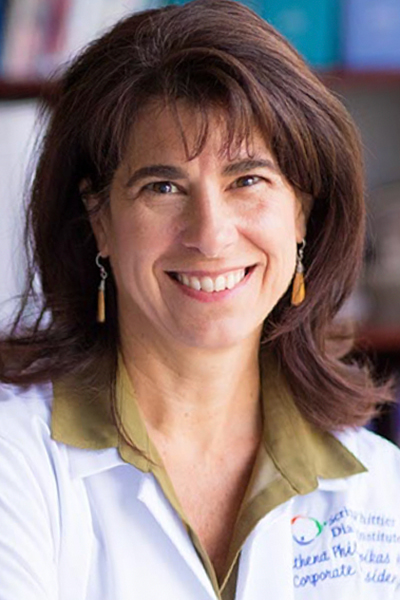During a virtual presentation at the Scientific Sessions, two experts with distinctly different backgrounds will debate the value of continuous glucose monitoring (CGM) in patients with type 2 diabetes. The one-hour session, which begins at 1:45 p.m. CT Saturday, June 13, is titled The Use of Continuous Glucose Monitoring in Type 2 Diabetes Mellitus—Is There Value?
Athena Philis-Tsimikas, MD, Corporate Vice President of the Scripps Whittier Diabetes Institute, brings more than 25 years of experience in diabetes care to the debate. As Director of Community Engagement at Scripps Research Translational Institute, she leads the Diabetes Care Line, which creates programs, conducts research, and delivers diabetes services to more than 50,000 diabetes patients.
Elbert Huang, MD, MPH, FACP, Professor of Medicine and Director of the Center for Chronic Disease Research and Policy at the University of Chicago, will present the economic side of the debate. He conducted the first cost-effectiveness analysis of CGM in type 1 diabetes more than a decade ago.

ADAMeetingNews.org spoke to Drs. Philis-Tsimikas and Huang for a preview of the debate.
Dr. Philis-Tsimikas: I would argue continuous glucose monitoring can benefit everyone with type 2 diabetes. CGM has demonstrated revolutionary benefit for the management of type 1 diabetes. Data also demonstrate benefit in insulin-requiring type 2 diabetes patients. And while there is less information and outcomes data for type 2 diabetes in earlier stages of disease, or even in those at risk with prediabetes, there is potential for increasing engagement in managing disease in these groups as well.
My enthusiasm for this modality of intervention stems from positive patient responses after initiation of CGM. I will share early data from our group on the use of CGM in English- and Spanish-speaking patients with type 2 diabetes when integrated as part of diabetes self-management education, as well as preliminary findings from our prediabetes participants using CGM in the Diabetes Prevention Program. I will also touch on how CGM has been used by large health plans as part of their motivational behavioral health coaching programs, and as part of their primary care management process.

Dr. Huang: The ADA audience will undoubtedly have strong opinions about continuous glucose monitoring. For the overall type 2 diabetes population, based on current evidence, continuous glucose monitoring is not yet a cost-saving or highly cost-effective technology—though there may be great value to the device in some populations and settings.
Before you shoot the messenger, allow me to specify what we mean by value. Value is kind of a vague concept, but in cost-effectiveness analysis, which is a branch of health economics, it actually has a very specific definition. Cost-effectiveness analysis is used by health systems across different countries to make decisions about whether a new drug or technology meets a threshold for good value. So we can be very specific when we talk about value. We have to think about value in the broader context of health care spending.
I know that Dr. Philis-Tsimikas will talk about CGM in the COVID-19 era—it is a way to obtain data from patients when we have to practice social distancing. But the flip side of that coin is that COVID-19 has produced an economic crisis. People are losing their jobs and their health care. So I’ll spend some time talking about how the COVID-19 economic crisis is layered on top of a health economic system in the United States that already had problems with unsustainable, rising costs. So this is important context for this whole debate. Assuming we have limited dollars, what is the best way to spend money in type 2 diabetes?
Dr. Philis-Tsimikas: I would argue CGM is a wise use of health care dollars. I’ll show how health systems may be able to integrate CGM into their diabetes self-management education programs and use it for wise medication management. And I will touch on how we are using CGM in the hospital setting to monitor and treat patients in light of the COVID-19 pandemic, and its usefulness in minimizing nurse contact with patients and reducing the use of personal protective equipment.
Dr. Huang: I will review the cost-effectiveness analysis data from type 1 diabetes. There are far fewer analyses for type 2 diabetes and the results of these studies are wildly different. But in no scenario does CGM actually save money. It improves health, but it costs us more. And, unfortunately, there’s still a budget limit problem. Hospitals and health systems have to make decisions on where to invest their dollars. Patients have limited ability to pay out-of-pocket costs. You have to make some tough choices. Fortunately, there are some very cost-effective ways to manage diabetes and reduce mortality, and I’ll talk about those.
And one day, CGM may move into the cost-effective category for type 2 diabetes. Most analyses assume the technology will become less expensive and more accessible. That would change everything.
VIEW THIS PRESENTATION
Already registered?
View this presentation at ADA2020.org.
Not yet registered?
Register now to access all presentations from the Virtual 80th Scientific Sessions.